








PUBLISHER
James R. Baker
GENERAL MANAGER
John Rusnak
EXECUTIVE EDITOR
Andy Walgamott
EDITOR
Chris Cocoles
CONTRIBUTORS
Mark Fong, Scott Haugen, Tiffany Haugen, Tim E. Hovey, Cal Kellogg
SALES MANAGER
Paul Yarnold
ACCOUNT EXECUTIVES
Janene Mukai, Tom St. Clair
DESIGNERS
Gabrielle Pangilinan, Lesley-Anne Slisko-Cooper
PRODUCTION ASSISTANT
Emily Baker
DIGITAL STRATEGIST
Jon Hines
ADMINISTRATIVE ASSISTANT
Katie Aumann
INFORMATION SERVICES MANAGER
Lois Sanborn
ADVERTISING INQUIRIES ads@calsportsmanmag.com
CORRESPONDENCE
Email ccocoles@media-inc.com
X @CalSportsMan Facebook.com/californiasportsmanmagazine
ON THE COVER
Wounded in Afghanistan and having lost his right leg, U.S. Army Marksmanship Unit
Staff Sergeant Kevin Nguyen of Westminster developed into a world-class Paralympic shooter and will participate in the Paris Paralympic Games, which begin on August 28. (USA SHOOTING)
MEDIA INC PUBLISHING
941 Powell Ave SW, Suite 120 Renton, WA 98057 (800) 332-1736 • Fax (206) 382-9437 media@media-inc.com www.mediaindexpublishing.com







It lacks nearby Lake Tahoe’s amenities and pizazz and it’s not exactly easy to get to, but French Meadows Reservoir needs to be on your list of Sierra trout fisheries to check out. It teems with hungry rainbows and browns and can make for a great day of fishing from boat or bank. Cal Kellogg shares all the details you need to know!
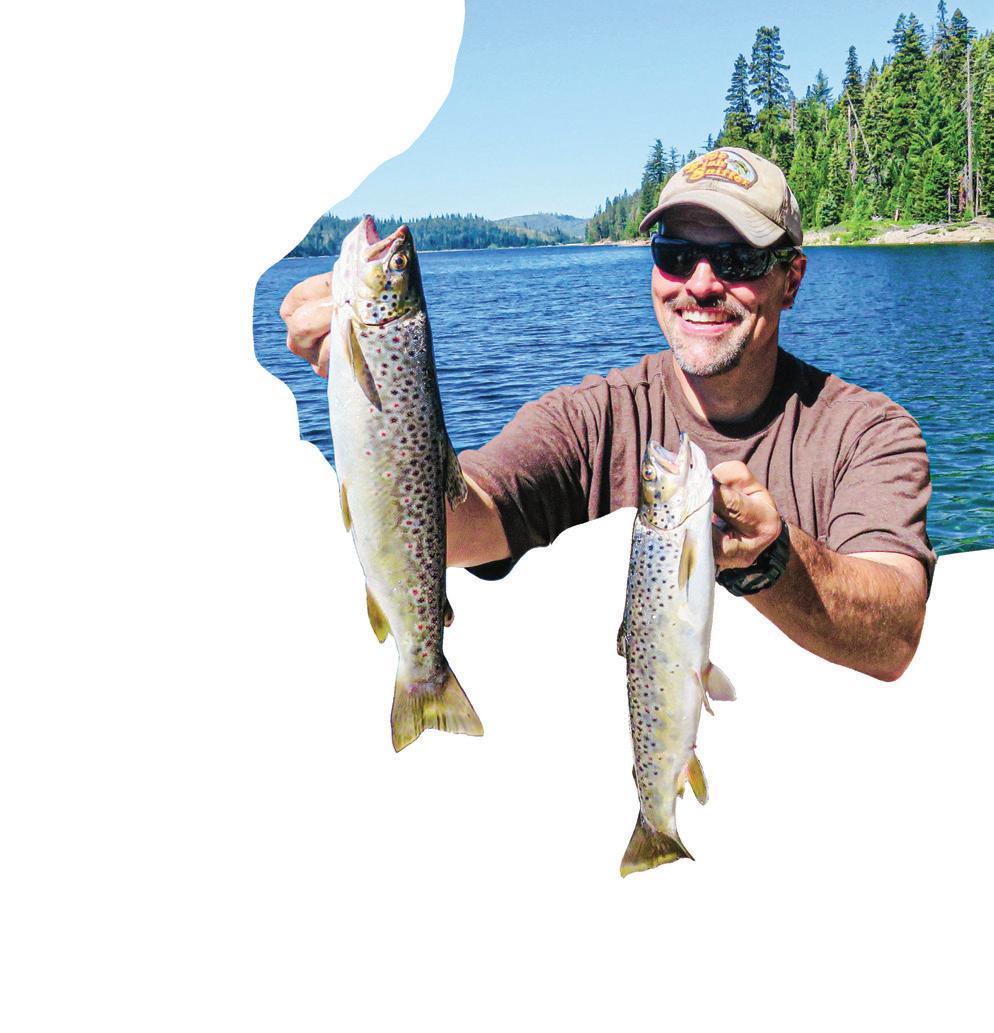
27 KOKE CLASSICS
Mark Fong picked the brain of a Northern California kokanee savant, guide Brandon Abernathy, for tips on taking home more of the feisty and delicious landlocked sockeye salmon that school in many of the region’s easily accessible lakes. From trolling and color suggestions, to how to kick up your corn offerings, Abernathy has the downlow for catching kokes.
57 WADE INTO THE PIGS’ DEN
As summer’s dog days lumber through August, it’s a great time to hunt wild boars in their bedding areas. Tim Hovey shares what years upon years of studying pig behavior and hunting them up close have taught him.
65 BEST IN BIRD HUNTING SWAG
Upland bird seasons are almost here, and our From Field to Fire guru Scott Haugen has you covered with the gear you need to prepare for September dove and fall quail and pheasant hunts, including an electric bike that’ll help you cover more ground. And chef Tiffany Haugen serves up a mushrooms-and-cream halibut dish!
Get the digital version of California
Don’t let seeds derail gun dog’s season
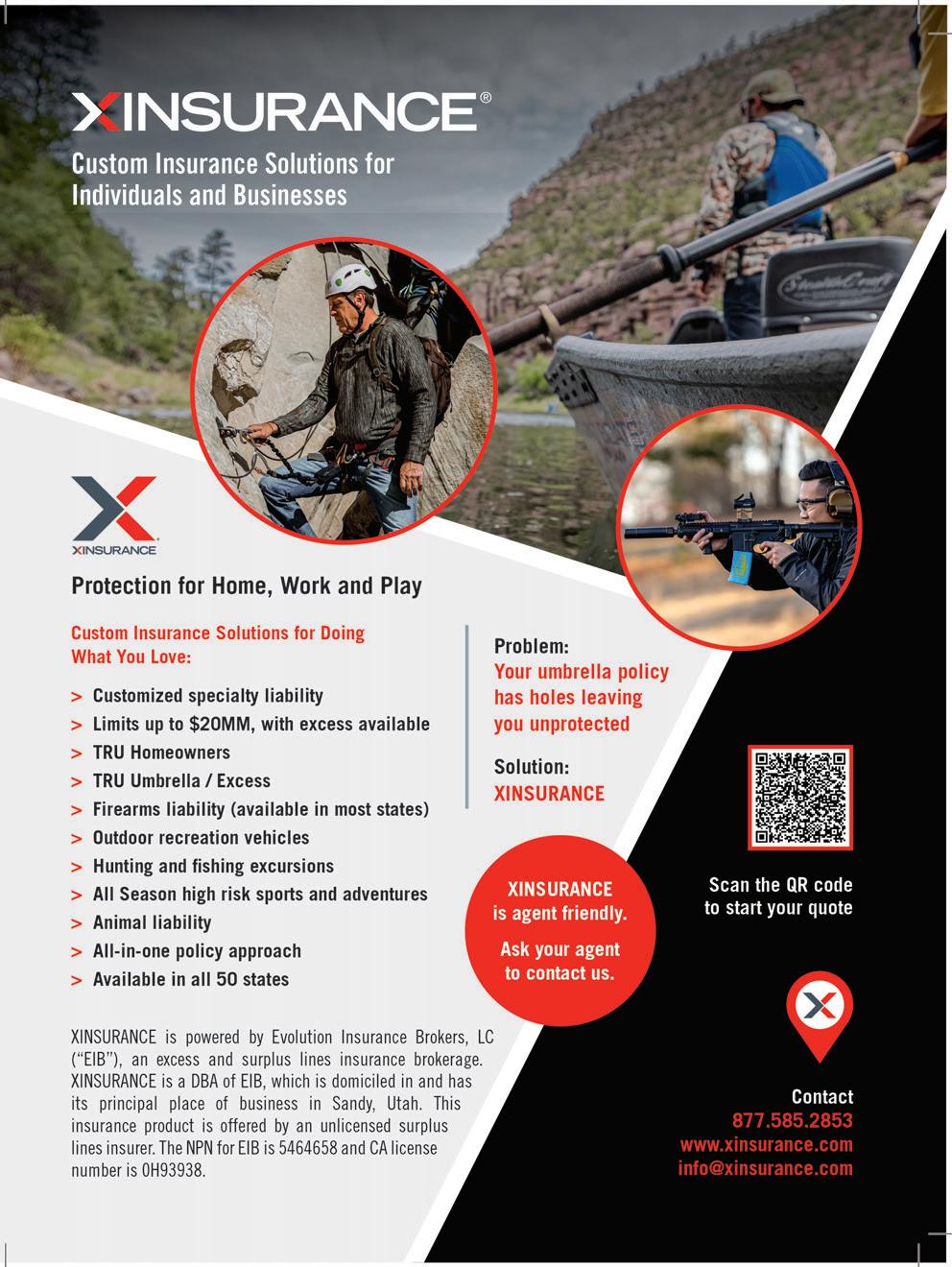

One of my favorite Christmas presents I ever gifted my late dad was a simple coffee mug that read “My Kid And My Money Go To Fresno State.”
Indeed, my father’s hard-earned dollars joined me on that collegiate adventure. Despite some squabbles between us as things unfolded, I hope I did my pop proud by earning my bachelor’s degree in journalism. He knew I loved sports and writing and wanted to pursue that career, which I did.
At the same time, I was proud he chose to leave high school early and join the United States Navy between World War II and the Korean War, serving some in the latter conflict before embarking on a long stint in the auto repair industry. He and I had different aspirations. I know I wasn’t a good candidate to join the armed forces and back in his day he had no interest in attending college, which brings me to this month’s interview with U.S. Army Marksmanship Unit Staff Sergeant Kevin Nguyen (page 44). Nguyen, a Southern California native,
is the son of immigrants who fled the Vietnam War for a better life in America.
Like my father, Nguyen chose to serve his country. He joined the Army, was wounded in Afghanistan and had his right leg amputated. A decade-plus later, he’ll represent the United States shooting team for a second straight Paralympic Games, this time in Paris. I’m so honored to share some of Nguyen’s thoughts about his injury, his family and why he’s proud of where his journey took him.
“The military is certainly not for everyone, but for those who feel called to it, you get out of it what you put into it,” he said. “Nothing will come easily, and your work ethic will determine your success.”
Nguyen earned my respect for just picking himself up after the catastrophic
war wound he suffered. Those who he works with on a daily basis rave about his character.
“He is certainly open to sharing his story if asked and always lends an ear to someone that might be having a difficult time. Those are the qualities that have helped him become a mentor and coach to many of the younger members of both our team and the U.S./Paralympic Team as well,” said Sergeant First Class Hank Gray, the Marksmanship Unit’s assistant team chief in international rifle.
“One would expect him to have a little bitter taste in his mouth about the Army and combat, but he doesn’t at all. It’s quite the opposite; his perspective about what happened and his feeling of duty to the country have driven him to stay on active duty and even pursue special operations. It’s truly inspiring!”
I’ll be cheering on Staff Sgt. Nguyen from home as he takes on the best of the world in France. I’d like to think my dad would be excited to read my words. -Chris Cocoles

was wounded in Afghanistan and lost his right leg, but his story of recovery and redemption as he heads for his second Paralympic Games should inspire all of us. (USA






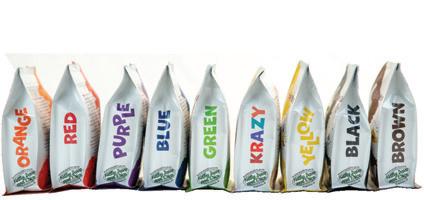









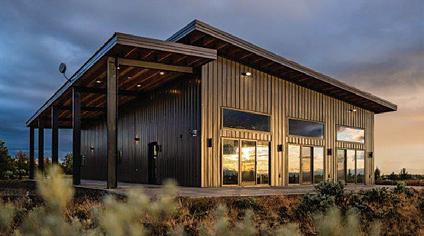
Reservoir,

August 10. (CAL KELLOGG)
1-15 First dove season dates
4-26 Northwestern Roosevelt elk general season dates
7 Shaver Lake Team Kokanee Derby; kokaneepower.org/ derbies
11-22 Marble Mountains either-sex Roosevelt elk apprentice season dates
11-22 Marble Mountains Roosevelt elk general season dates
14 Zone Q1 mountain quail season opens
14 Stillwater Classic catch-and-release fly fishing tournament, Crowley Lake; crowleylakefishcamp.com/new-events/ stillwater-classic
14 Opening of sooty (blue) and ruffed grouse seasons
14-22 White-tailed ptarmigan season dates
21 Remainder of Zone B, all of Zone C, and D-6, D-7, X-9a, X-9b and X-12 general deer seasons open
21-29 Northern Zone bandtail pigeon season dates
25-Oct. 6 Mendocino Roosevelt/tule bull elk season
28 Zone Q2 all-quail season opens
28 Zones D-3, D-4, D-5, D-8, D-9, D-10, X-8 and X-10 general deer seasons open
Fishing/Free-Fishing-Days
For a list of upcoming bass tournaments, go to nrm.dfg. ca.gov/ FishingContests/default.aspx.

Are you catching as many trout as you should be? Are fish slipping from your grasp? If you want to land more and bigger trout, author Cal Kellogg’s eight rules of trolling will help. (CAL KELLOGG)

By Cal Kellogg
Between guiding and producing videos, I spend an average of 150 days a year out on the water trolling for trout. While I don’t consider myself a trout trolling expert, when you spend that amount of time doing anything, you can’t help but develop some hard and fast rules.
My guide service is unique because catching trout is only part of the day’s focus. I offer instructional guide trips and the goal is to help my clients catch more and bigger trout while fishing aboard their own boats or kayaks in the future.
In this article I’m going to share the same dos and don’ts with the readers of California Sportsman that I drive
home to my clients out on the water.
RULE 1: DO YOUR HOMEWORK
Before you head out to fish a new lake, spend some time determining what the trout feed on and how large the fish grow. Valley and foothill reservoirs featuring forage such as pond smelt and threadfin shad call for different lure choices than higher-elevation
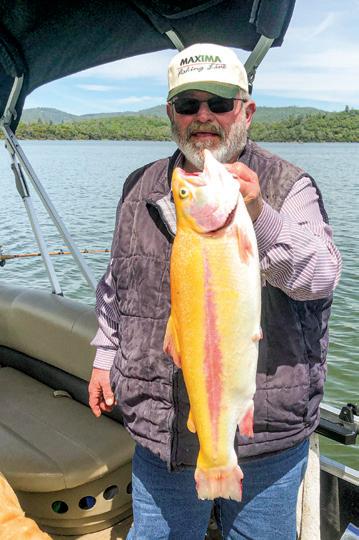
lakes, where the trout spend most of their time feeding on insects.
In general, when fishing a lake where the dominant forage item is pond smelt or shad, baitfish-imitating lures, flies and soft plastics are a logical starting point. If you are visiting a “bug lake,” one where insects are the dominant forage, bright-colored lures tend to work well.
In the latter situation, you’re not going to imitate an insect with trolling gear, so by using brightly colored lures you are hoping to tempt the trout into striking out of curiosity. Typically, high-elevation trout are more aggressive feeders than their lowland cousins, which causes them to be more willing to bite.
At valley and foothill reservoirs
Ron Little fished with Kellogg three times this spring. He wanted a trophy-size lightning trout. Fishing with a plan ultimately put the fish on the end of Ron’s line and into Cal’s waiting net.
with large trout and a forage base of shad or pond smelt, size-appropriate baitfish-pattern lures are your best weapon for hooking a large trout.
Up in the high country, lakes featuring large trout often have kokanee salmon populations and big numbers of small rainbows. In these lakes, 8- to 10-inch salmon and immature rainbows are a favorite meal of trout in excess of 4 pounds.
In lakes where big trout gobble smaller fish, large plugs and flies that imitate small- to medium-sized kokanee and rainbows are often the best offering for hooking a trophy.
Along with determining what the trout feed on and which lures work the best, it’s wise to do a little more research before your next fishing trip.
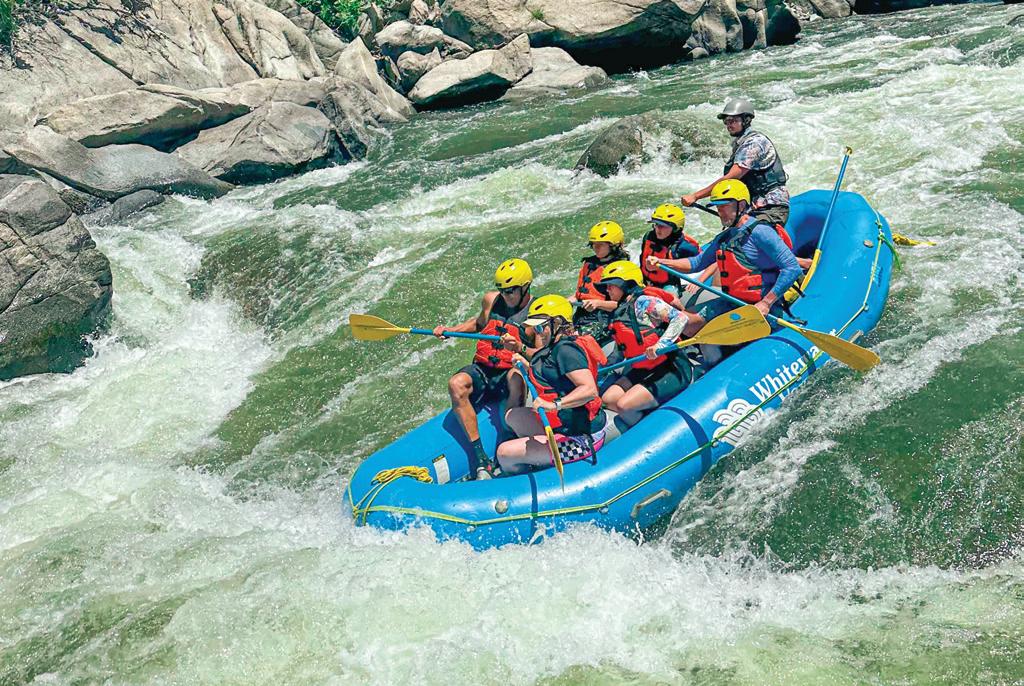



The Kern River Valley awaits those adventurous vacationers such as this group on a whitewater rafting trip on the lower Kern River.



Lake Isabella full and beautiful after the reconstruction project to insure the safety of downstream communities from flooding.
Water sports and enjoyment are the name of the game in the Kern River Valley.
Conact the Kern River Valley Chamber of Commerce for free brochures, information and contacts.


Are the fish biting well? How deep are other anglers scoring? Are the trout holding in the main body or up the river arms? What is the lake level and surface temperature?
Knowledge is power when it comes to trout fishing success!
Back in the 1980s, when the San Francisco 49ers started winning Super Bowls, their coach, Bill Walsh, scripted the first 20 offensive plays of the game. Only after the team had run those 20 plays would he begin making adjustments. I strongly encourage you to take a similar approach on your trout trolling adventures.
Whenever I go fishing, I have three plans. Plan A is my best guess

as to what is going to work; B and C are fallback plans I break out in the event Plan A fails to produce. When you do start catching fish with one of
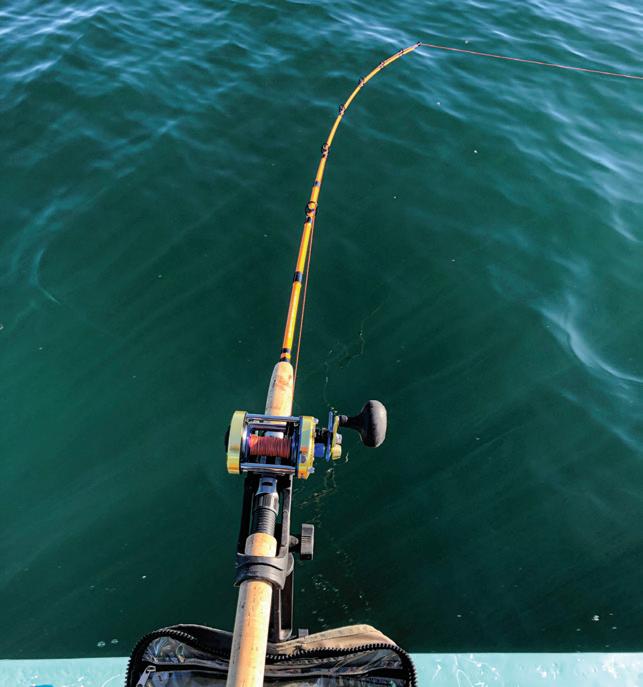
has found that when trout are in the top 20 feet of the water column, trolling with leadcore line almost always outfishes running setups off downriggers. (CAL
your preplanned approaches – but don’t feel you’re doing quite as well as you should be – that’s the time to start making incremental changes in terms of lure color, trolling speed and depth to see if you can turn a fair bite into a great bite.
RULE
This rule goes hand in hand with fishing with a plan. Please don’t be the angler who constantly changes lures and goes zipping up and down the lake looking for that special spot.
Trout trolling success at the highest level is all about building patterns. Where are the fish situated? What will they hit? What is the best trolling speed? Remember, magic lures and secret locations don’t exist. Patience is your greatest asset when it comes to building a pattern and catching trout.
Trout don’t constantly feed all day every day. Arrive at the lake with a solid plan built around lures you have confidence in and then fish them hard, giving those presentations every chance to succeed.
Here’s how I build a pattern: Let’s say I have a boatload of clients and I’m running four rods with four different lures. Catching one fish on a lure doesn’t tell me much. If I catch two fish on a given lure in a short amount of time, I put a second identical lure into the spread. If a third fish comes on the same lure in a reasonable amount of time, I put out a third lure of the







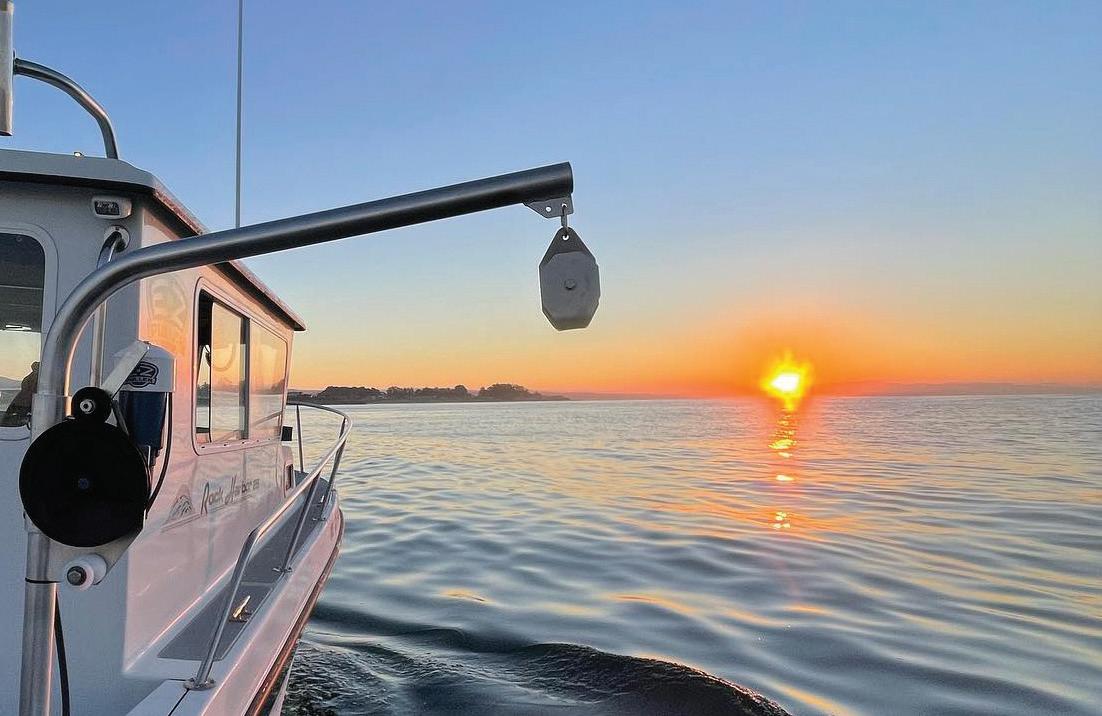

same type and color. I seldom put on a fourth identical lure, no matter how good the bite is, because the other lure on the fourth rod is my benchmark presentation. It helps me determine if the bite is changing. It’s also the rod I experiment with. If the trout are hitting chrome spoons well, will they hit copper even better? The fourth rod allows me to answer that question. Always be mindful of this: When the trout begin biting, make the most of it and hook as many fish as fast as you can before they go off the bite.
RULE 4: CUT THE LAKE DOWN TO SIZE AND NEVER LEAVE BITING TROUT TO FIND TROUT
I was trolling from my pedal kayak at Lake Davis a few years back. I’d found a small low spot in a shallow bay. The low area was about 200


Downriggers are a great tool to utilize when the trout are holding in deep water, but don’t overuse them. If the surface temperature is 65 degrees or less, the most aggressive trout will almost always be found in the top 15 feet of the water column. (CAL KELLOGG)


yards long and maybe 50 yards wide; it was holding some really nice 2to 4-pound rainbows. They were gobbling orange trolling flies and I was having a great time hooking fish after fish.
At one point, a small boat trolled through the area. The angler hooked and landed a rainbow in the 3-pound class and kept right on trolling down the lake. Did the angler catch more trout that day? Probably, but he stumbled on an epic bite, landed one fish and left. Don’t be that guy!
Your goal should always be to eliminate unproductive water, and
then when you find willing trout, cut the lake down to size and work the fish hard. Never leave a productive area or group of biters until the action dries up and they give you a reason to leave.
One of the ways you can stack up a big number of hookups in a short amount of time is to keep your offerings in the strike zone. Never forget that one of the best ways to land a trophy trout is to land a lot of trout.
Trollers have a tendency to fish too deep. The surface temperature is the deciding factor in how deep I fish.
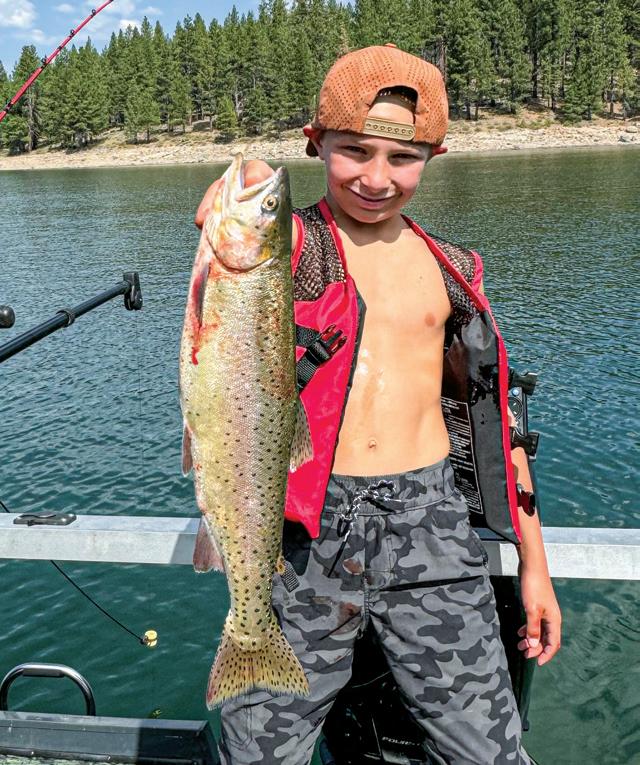
If I’m targeting rainbows and the surface temperature is 65 degrees or less, I know there will be trout near the surface early, late and anytime there is a breeze ruffling the surface.
I seldom drop down below the 15foot mark during the late fall, winter and early spring. When the surface temperature is 65 or below, the most active fish will be near the surface, so that’s where I want my offerings positioned. A large percentage of the fish beyond 8 pounds my clients catch over the course of the season are hooked in the top 10 feet of the water column.
Rainbow trout originated in streams. They want to feed up. You always want your lure positioned over the top of the fish. They want to move up, intercept the prey item and then drop back down.
Even if the surface temperature is 85 degrees and you are marking trout 100 feet deep, you still want to position your offering 5 to 10 feet above the main biomass of trout and bait.
Their origins in streams also explains why trout feed more aggressively when the breeze creates surface chop. Trout love to orient in the current. What you and I see as wind-generated waves and whitecaps, the trout see as current.
If there are trout holding 10 to 15 feet deep and a stiff breeze comes up, you can count on those trout to pull up into the top 5 feet of water in order to position themselves in the wind-created current.
I came up with what I call the hybrid leadcore rig. It consists of a 50-foot mono topshot, three colors of leadcore and 20-pound braid backing. This rig allows me to fish up to 20 feet deep with light tackle. I’ve found that head to head, my leadcore rig will outfish a downrigger almost every time if the trout are in the top 20 feet of water.
Why is this the case? I’m not sure and, frankly, I don’t care. All I know is
2.8L












leadcore has a quality or qualities that allows it to outperform a downrigger. As a result, from late fall through early spring the downriggers on my boats and kayaks get very little use. Instead of running downriggers, I make use of leadcore rigs and toplines to generate strikes.
Fluorocarbon reflects light at about the same rate as water. For all practical purposes, this makes fluorocarbon invisible to trout. Some days you can catch plenty of trout without using fluorocarbon, but on other days you might not get a strike without it. There is no way to determine when you’ll need fluoro and when you won’t, so I use it all the time.
I also caution my clients not to go too light in terms of leader breaking strength. Most of the time – even when I’m fishing ultraclear water – I
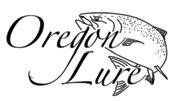
go with 8- to 10-pound test. While I catch trout of all different sizes, my focus is always on hooking and landing big fish. When you hook a 10-plus-pound trout, that is not the time to be praying your 4-pound leader material will hold!
When speaking at fishing seminars or just chatting with clients, I’ll often ask folks what their plan is for landing a really big trout – say, something over 8 pounds. The question is a real crowd-stopper and is often met with confused looks and nervous mannerisms. I’ve met very few anglers who have had a ready answer. To land a certifiably huge trout, nine times out of 10 you’ve got to have a plan and execute it flawlessly. Big trout have a way of getting away at the last second, and very often when you get a big trout to the boat, you’ll only get one shot at netting it.



Giant trout don’t show up every time you hit the water or even every season; that may be the reason most casual troutheads don’t have a plan for landing one.
The first thing I do to set the stage for big trout success is make certain my gear is up to the challenge when a jumbo fish comes knocking. As I said, I never go below an 8-pound fluorocarbon leader. I check the drag setting on my reels multiple times per day to make certain they didn’t get overtightened by accident. I make certain every knot is tied perfectly. If I find a bad spot in my line, I replace it immediately. Would you race in the Indy 500 if your car wasn’t working perfectly? Of course not, and the same goes for the trout fishing gear you are going to battle a trophy with.
Let’s say you’ve hooked the trout of a lifetime, your gear was up to the task, you remained cool, kept the boat in gear, and moved forward. Now is
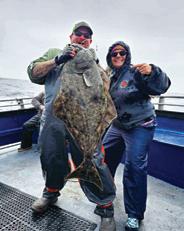





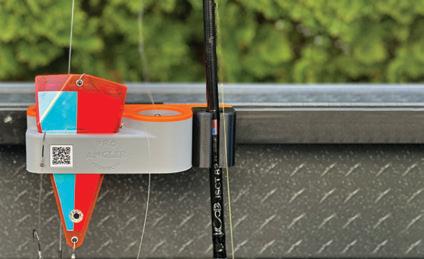








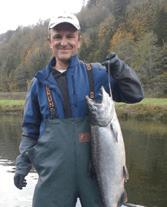


the moment of truth. It’s time to net the fish. Netting a big fish by yourself is a challenge, so I’m going to assume you are fishing with a partner and you’ve had the forethought to purchase a net with a long handle and a large hoop. If you’re the angler on the rod, it’s your job to lead the tired fish to your partner with the net and to lay the fish out on the surface with its head up.
If you’re the netter, keep the net away from the fish until the final second so that you don’t tangle the gear with the net when the fish is still hot. You never want to stab at a fish with its head down. If you do, the trout will dive and you’ll hit the leader, likely dislodging the hook.
A lot of folks make the mistake of trying to net a big trout tail first. This seldom works out. When the trout senses it’s being trapped it’s going to surge forward; that’s why you always net big fish head first, so that they swim deeper into the net when they panic.
If your gear is up to the task, your drag is set light and you have a netting plan, you and your partner won’t be prone to panic and you’ll likely put that monster trout into the boat! CS
Editor’s note: Cal Kellogg is a longtime Northern California-based outdoors writer. Subscribe to his YouTube channel Fish Hunt Shoot Productions at youtube.com/user/KelloggOutdoors.

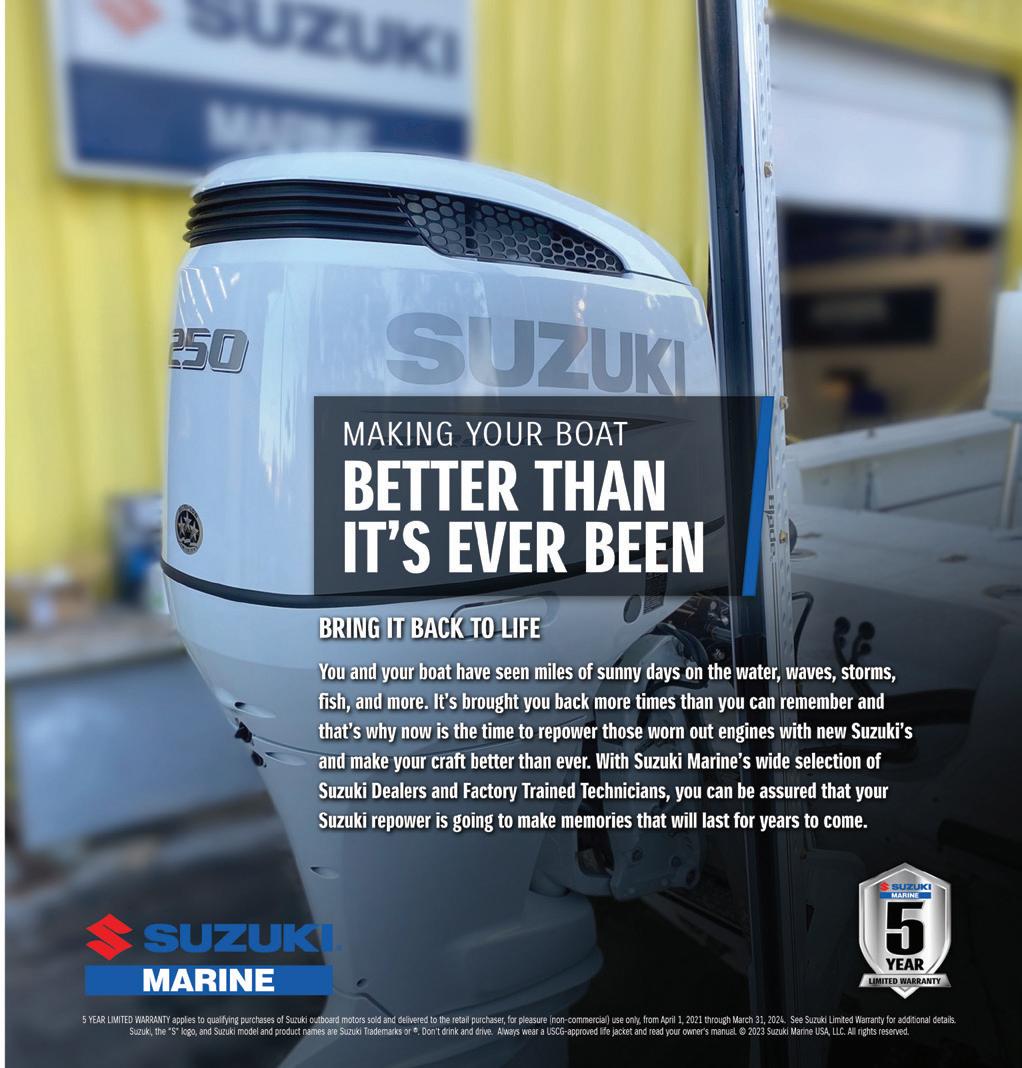




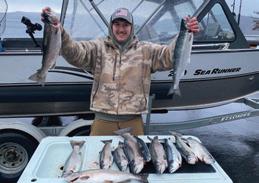


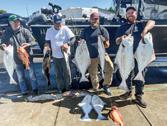









Landlocked sockeye salmon, known as kokanee, provide great action and delicious table fare. Several lakes around Northern and Central California offer great options for anglers. (BRANDON ABERNATHY/ROD DOWN GUIDE SERVICE)

By Mark Fong
While kokanee can be caught throughout the year, the summer months are considered to be prime time on the lakes and reservoirs across Northern and Central California.
When the bite is on, fishing can be fast and furious, making kokanee very popular. In addition to the catching, kokanee are excellent table fare.
Just in time for the peak of the season, we asked NorCal kokanee guide Brandon Abernathy of Rod Down Guide Service (roddownguide
.com) to share a few of his top trolling tips for putting more fish in the boat.
According to Abernathy, color and lure style go hand in hand.
“Kokanee can be really colorselective,” he says. “You really need to experiment with colors until you find the one they want, and be aware that color can change each day. My three go-to colors are pink, green and orange. As far as lure styles, you need a good selection of different-sized hoochies, some type of spinner and a T-Bone Tackle flutter-style spoon.”
As for dodgers, Abernathy’s favorite is a J&J Tackle moon jelly nickel Sling Blade in the 3.5- or 5.5inch size. He’ll use the moon jelly regardless of which color or style lure he is trolling. During the early part of the season when the kokanee are shallow, he selects the 3.5-inch version. Later in the year when the fish are below 30 feet, Abernathy will upsize to the larger 5.5-inch version for more flash in the deeper water.
Abernathy typically runs an 8- to 10-inch leader from the lure to the dodger. The shorter the leader, the more action the dodger imparts to
the lure.
Kokanee trolling is a system, so having the right rod and reel is just part of the equation. Abernathy likes a long rod designed for kokanee trolling, favoring those in the 7-foot, 9-inch to 8-foot range. He is sure to match it up with a linecounter reel such as the Daiwa Lexa 100 LC, which he spools up with 8-pound P Line CXX.
Tipping your lure with a piece of corn is standard practice for kokanee anglers. Some anglers get really creative and secretive with their corn recipes, adding all kinds of different ingredients, from garlic to anise oil and maple syrup, and more.
“Everybody seems to have their own thing when it comes to corn,” explains Abernathy. “The way I like to do it is simple and easy. I just add the oil from a can of tuna to a bottle of Pautzke’s Fire Corn. A lot of guys like to use canned shoepeg corn, but for me, Fire Corn gets bit more and stays on the hook better.”
“I have tried them both, one side of the boat with one and one side with the other. In fact, the other day when I was out fishing, the kokanee definitely wanted the Fire Corn more than they wanted the shoepeg corn.”

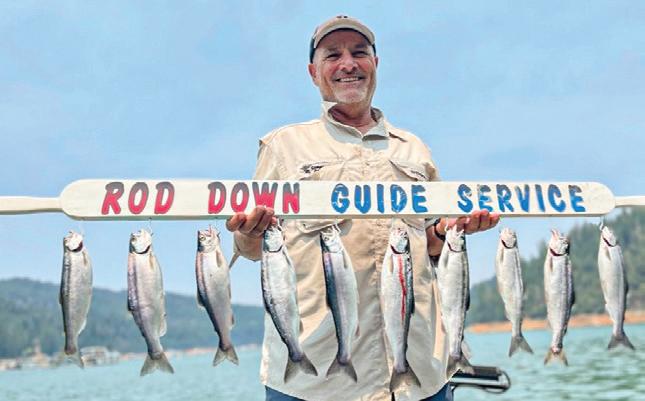
“Speed matters,” says Abernathy. “If you get into a school that won’t bite, you need to slow down or speed up and go back to where you were. A lot of time those fish will follow the lure and that little bit of variability – a turn, a speedup or a slowdown – will trigger that bite. It’s been proven that fish will follow a lure a long way, so a speedup, where they think it’s gonna get away from them, will trigger ’em to snatch it right up. A drop in speed makes the lure look like it’s injured and they’ll bite it too. On a turn, the outside rods will speed up and the inside rods will slow down.”
As a general rule, Abernathy prefers to keep his trolling speed





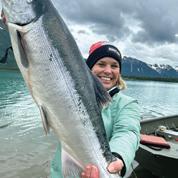







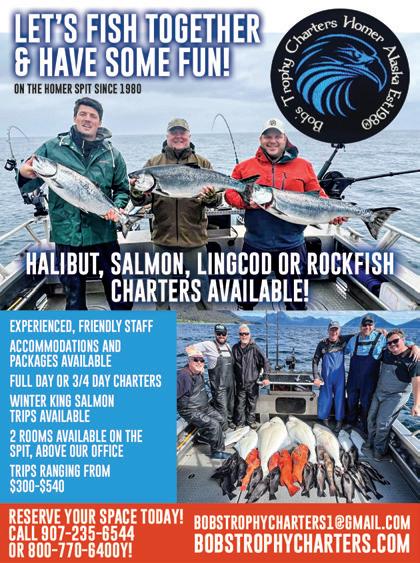


between 1.4 mph and 1.6 mph, which is a little faster than the 1.0 to 1.3 that many kokanee trollers typically adhere to.
Finally, you can’t catch them if you can’t find them, making electronics a very important piece of the puzzle. Once he has located the kokanee with his graphs, Abernathy likes to stagger his downrigger depths. For example, if he marks fish at 35 feet and he is running four rods, he will set the lines at 33, 35, 38 and 43 feet, respectively. This allows him to determine the most productive depth.
It is important to note that the fish will almost always change depth during the course of the day, making it equally important for the angler to change as well.
Kokanee fishing can seem overwhelming, but with a bit of knowledge and time on the water, you can be on your way to enjoying this awesome fishing opportunity. CS
Editor’s note: If you would like to get a kokanee fishing lesson in person, contact Brandon Abernathy at (707) 927-6745 or message him on Facebook at RodDown Guide Service. In addition to kokanee, Abernathy guides for trout, landlocked king salmon and striped bass.
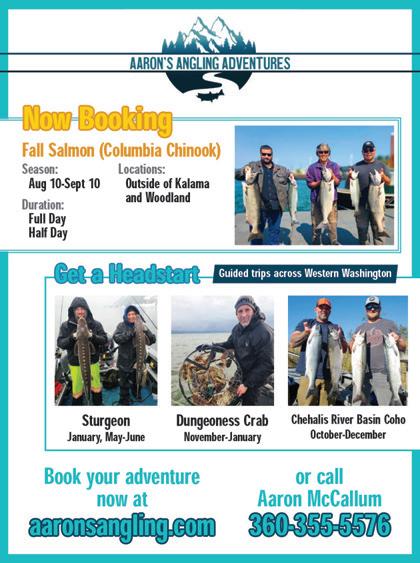
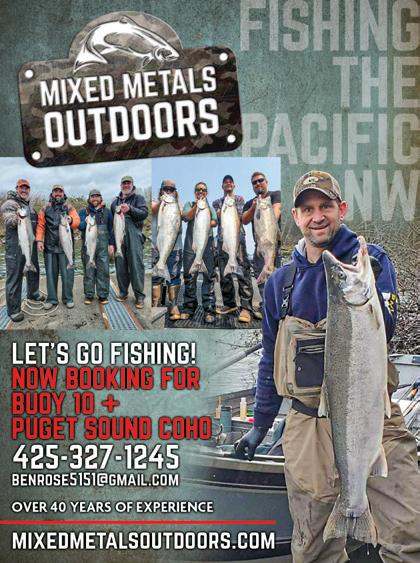

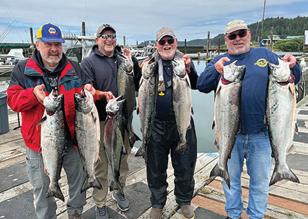














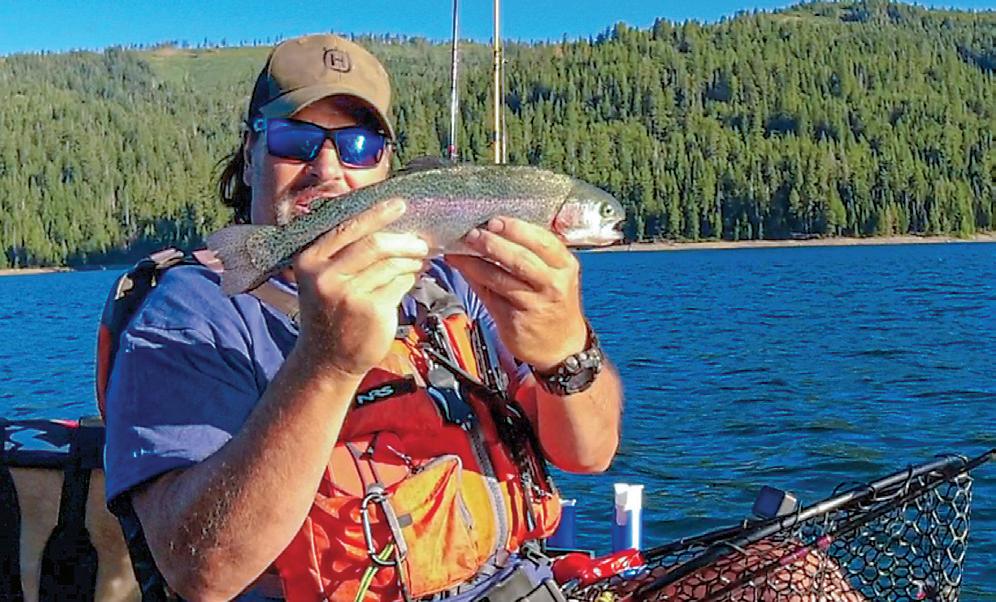
By Cal Kellogg
Afresh breeze was blowing from the direction of Lake Tahoe toward the sprawling Sacramento Valley far to the west. The easterly wind is a weather phenomenon occurring nearly every morning near
this section of the Sierra Crest, when temps are refreshingly cool in Tahoe and sizzling hot in the valley.
The phenomenon probably has a name, but I’ll leave the weather science to the meteorologists. I’m here to talk about trout fishing!
I didn’t care what was driving the
breeze. What mattered to me was the fact that the stiff breeze was driving the surface chop down the length of the lake. What us anglers see as chop and whitecaps, the trout see as current. At this moment, a concentration of rainbows had pulled up into the wind-created current and were on an
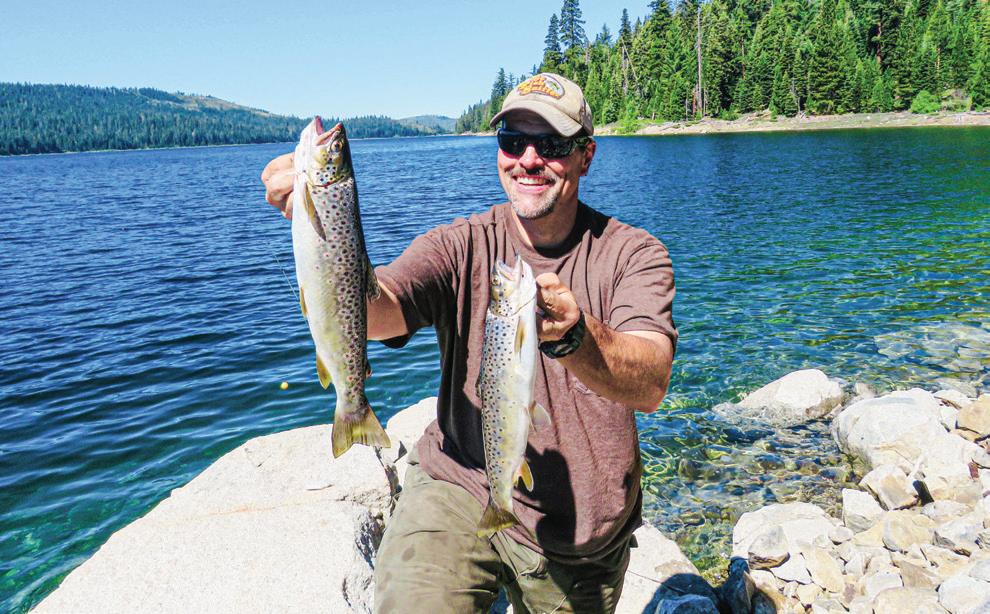
enthusiastic feeding binge.
My first two passes across the reservoir’s river channel on the upper end of the lake had produced a pair of handsome rainbows measuring 14 and 16 inches, respectively. Pedaling hard to drive the Hobie kayak into the wind and current, I came around for a third pass through the trout zone.
I’d gone less than 50 yards when my downrigger line popped off the clip and the rod pulled down into a deep arch. Initially, the rod acted as if I’d snagged the bottom, but that was impossible since I was over 80 feet of water.
Snatching the rod from the holder, I smoothly cranked the reel as I worked the kayak’s pedals just enough to keep the watercraft from spinning like a top in the wind. The fish was heavy and determined to stay down.
For the first several seconds of the fight I was thinking brown trout all the
way, but when the rod bucked with a flurry of headshakes a beat before the fish exploded from the surface, I knew it was likely a rainbow.
Over the next couple minutes, the trout pulled every trick in the book, including jumps, power dives, sharp runs and violent headshakes. The mantra, “Please stay on. Please stay on. Please stay on,” played in my mind throughout the fight. I was releasing all trout on this day, but this was a fish I desperately wanted to see.
When the rainbow showed beside the kayak – big, robust and chromebright – I was taken aback by its size. At a glance, I could tell the trout was at least 3 pounds, hands down the biggest rainbow I’d caught in my 20-plus fishing seasons at the lake.
After sliding the rainbow into the net, I worked to remove the hook from the gristle in the corner of the trout’s jaw and noted the big fish was
a planter. It had been in the lake for a while based on the new growth on the tail, but it was clearly a fish reared in the cement raceway of a hatchery. This came as a surprise that I’ll talk more about in a bit.
With the surface temperature hovering at 69 degrees, I revived the rainbow in the net until it showed signs it was ready to go, and then released it back into the cool depths.
Due to road closures in the wake of the 76,000-acre Mosquito Fire back in fall 2022, I hadn’t been able to access my home trout lake, French Meadows Reservoir, for nearly two years. My early-July reunion with the impoundment was memorable. Three hours of trolling produced 15 trout, a mix of wild fish and ex-hatchery ’bows ranging from 1 to 3-plus pounds!
French Meadows is formed on the
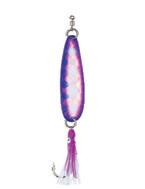
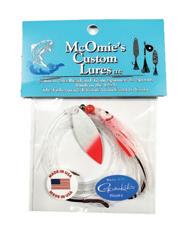
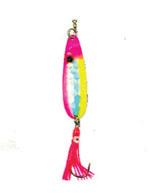












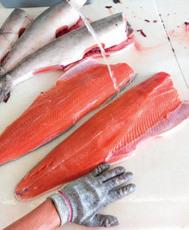


upper reaches of the Middle Fork of the American River deep in the Tahoe National Forest, about 9 miles from the Sierra Crest. By high-country criteria, the reservoir is large – 8 miles of shoreline and 1,900 surface acres of water when at full capacity.
The lake sits between two heavily timbered ridges. Prior to construction of the dam, there was a meadow in the valley and it was underlain by the soft duff and rounded rocks of an ancient glacial moraine. The rich soil that once sustained a lush expanse of grass now fuels a robust assortment of aquatic insects, crawfish and minnows, which in turn keep the reservoir’s rainbows and browns well fed and healthy.
When you travel to French Meadows, your first glimpse of the lake is a view from the dam. The lake appears roughly oval in shape and contains no obvious points or features. As you become familiar with the lake, however, you realize it’s dotted with small points and flats, steep drop-offs, rock slides, rock formations, huge boulders, steep channels cut by snowmelt before the reservoir was constructed, tree stumps, and more. In short, the
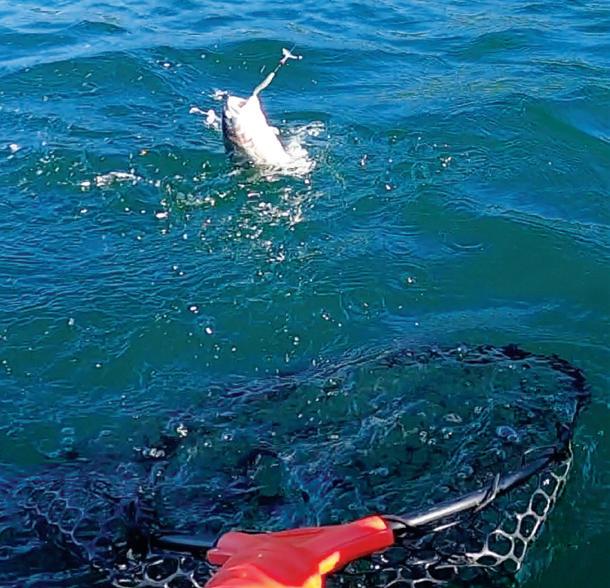

is the river channel running the length of the lake. This channel runs from 80 to 100-plus feet deep and provides the lake’s trout population a coldwater sanctuary in even the warmest summer conditions.
The nearest population center to French Meadows is Foresthill, in Placer County, and the drive to the lake via Forest Service Road No. 96 –Mosquito Ridge Road, as it is known by the locals – is only about 35 miles, yet it will take you a full 90 minutes to reach the lake because the narrow paved road is full of twists and turns as it navigates the rugged canyons of the American River watershed.
When you get to the lake, there are two major campgrounds on either side and a large group camp near the headwaters. The camps feature running water and vault toilets.
This is bear country, so if you decide to camp you should count on bears visiting your camp during the night, so stow your ice chest, food and trash







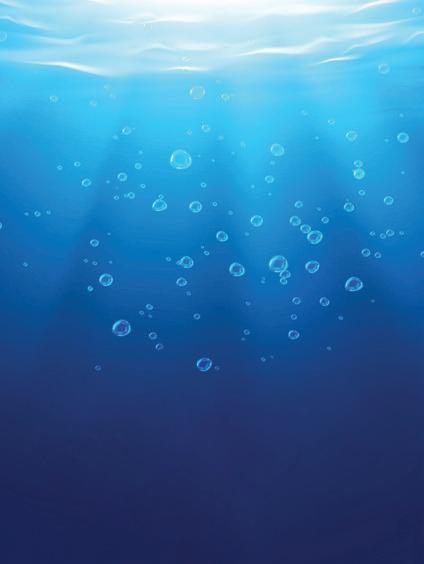

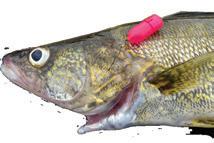



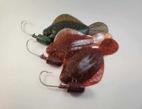
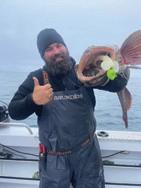


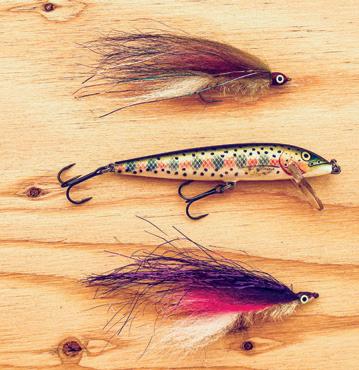
in the bear box within your campsite.
For a long time, because there were no bear boxes, ice chest bear predation was a nightly occurrence. The addition of the bear boxes has put a major dent in these incidents, but the bears are still around. You’ve been warned!
For boaters and kayakers, there are simple concrete boat launch ramps on both the north and south sides of the lake, but there are no floating docks.
Both brown trout and rainbow trout call French Meadows home. Rainbows are the most common catch. The lake plays host to wild rainbows, planters and holdovers.
Getting back to the big planter I
caught at French Meadows recently, for decades trout planting at the reservoir was done by the California Department of Fish and Wildlife, which stocked your typical 10- to 12-inch government trout. Some of them were caught and some survived to become sleek holdovers.
More recently, the Placer County Water Agency took over planting responsibilities at the lake, and rather than only planting pan-sized catchable trout, they’ve invested the money to purchase some large trophy-caliber rainbows that range up to and beyond 5 pounds.
As good as the rainbow trout fishing at French Meadows was in the past, I anticipate it will be even better in the future. That’s not something




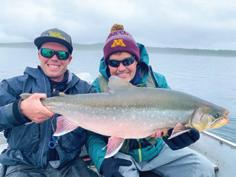

“As
good as the rainbow trout fishing at French Meadows was in the past, I anticipate it will be even better in the future,” Kellogg writes. “That’s not something you hear about many California fisheries these days!” (CAL KELLOGG)
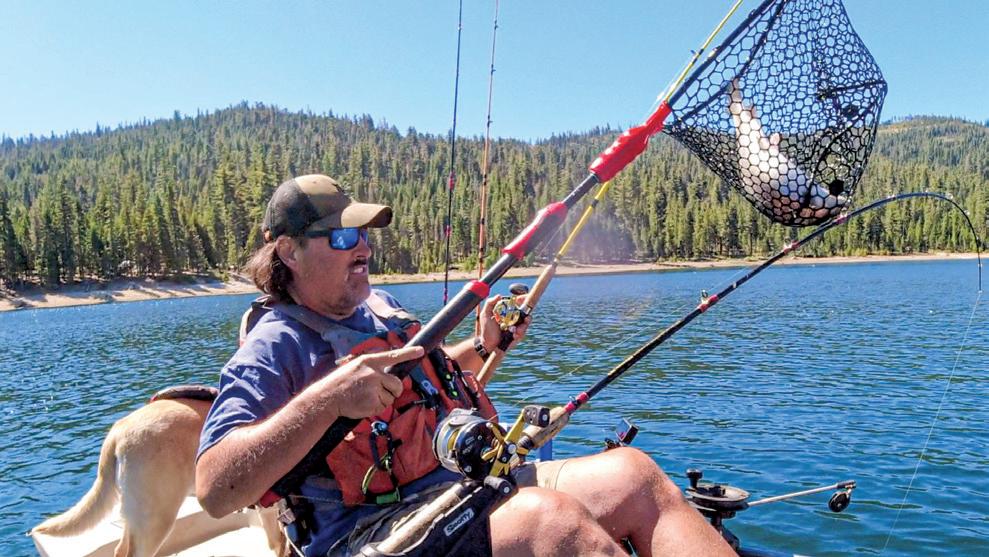
you hear about many California fisheries these days!
French Meadows’ brown trout are harder to catch than rainbows, which is typical, and they grow much larger than the ’bows too. My personal-best brown at French Meadows was in the neighborhood of 6 pounds; I’ve seen much bigger browns when pulling my underwater camera around dropoffs and rock piles.
When these big fish come close to the camera, it’s clear from their body language that they have no intention of biting. Instead, they are curious about the camera and come in to check it out before peeling off and heading back into deep water.
Access to French Meadows is also dependent on the weather. The roads to the lake are not cleared of snow, so once the white stuff starts to fly, access to the lake for most is cut off. Typically, you can fish the lake up until late October or into November, depending on the weather.
Following lighter winters, access
to the lake is usually restored in early May, but if the previous winter dumped a large amount of snow, you might not be able to get to the lake until late May or even June.
Bank fishing at French Meadows can be productive all season, but the best fishing for bankers takes place in the spring and fall, when cool water temperatures bring the trout in tight to the shoreline to feed.
In spring, I really like to target browns from the shoreline. I do this utilizing two rods. On one rod I soak an entire inflated nightcrawler pinned on a Carolina-style rig in 8 to 10 feet of water. On the second rod I fan cast with a 3- to 4-inch Countdown Rapala. My favorite colors are rainbow trout, black over silver and black over gold. My largest French Meadows brownie came on a gold Rapala on a cloudy, windy spring afternoon. And I’ve caught several 4to 5-pounders on worms.
For targeting rainbows from the bank, I utilize a similar two-rod approach. On the bait rod I soak PowerBait and on the casting rod I throw two basic offerings. The first is a ¼-ounce Kastmaster in a chrome/blue, brown trout or gold finish. The second is a clear plastic bobber teamed with a No. 6 Woolly Bugger in black, olive, brown, pink or orange. With this rig, I always fill the bobber completely full of water. This way the rig casts like a bullet and the bobber will sink a bit, allowing you to count the rig down 5 or 6 feet below the surface.
When trolling French Meadows from a kayak or power boat, I use a simple approach. For big browns early and late in the season, 4-inch Rapalas, large trolling flies and whole threaded worms are my offerings of choice, and I team them with fluorocarbon leaders and a lot of patience. Overcast, windy and bad-weather days offer the best opportunity for hooking the brown of your dreams.

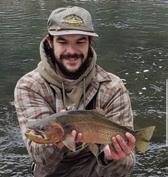










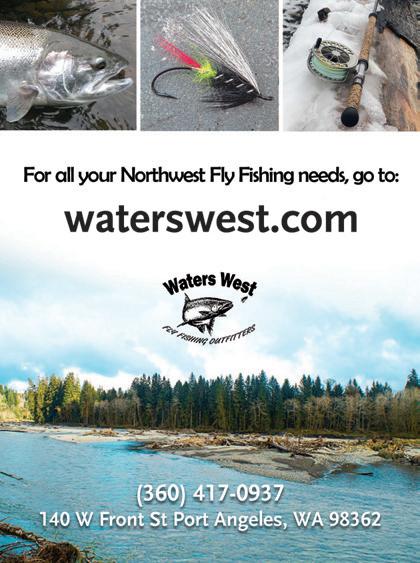
For rainbows, spoons will almost always put some trout on the grill. Bright colors like hot orange and pink will tempt rainbows, but it’s wise to have some more subdued metallic-tone spoons; gold and copper are my favorites.
Prior to this season, my personal-best rainbows at the lake had been 18- to 20-inch wild fish or holdovers. I got all of them on copper Trigger Spoons and Speedy Shiners trolled at 2.5 mph from my kayak.
French Meadows rainbows are often suckers for soft plastics like grubs, Trout Trix worms and Trout Trix minnows. As with spoons, sometimes the bright stuff works great, but at other times the ’bows show a preference for natural-colored offerings.
When the going gets tough and the ’bows are playing hard to get, it’s time to break out the nightcrawlers. Half a threaded ’crawler trolled naked or behind a small dodger at 1.5 mph is something French Meadows rainbows can seldom resist.
In the spring and fall, trollers can expect the action to be solid in the top 15 feet of the water column. During the dog days of August, you’ll need a downrigger to get your offerings down into 25 or 30 feet of water for the best results.
If I were going to visit the lake only once a year, I’d plan my trip as late as possible in fall, when the lake level is down and the trout have an instinctive urge to feed knowing that the long, lean days of winter are right around the corner. CS









By Chris Cocoles
Kevin Nguyen, the Southern California-born son of immigrants who fled Vietnam during the horrific conflict there in the 1960s and ’70s for a better life in America, knew the risks he’d take by enlisting in the United States Army.
But when his unit was fighting in Afghanistan, Nguyen’s military career – not to mention his life – became something altogether different in a flash. On February 2, 2013, after stepping on an improvised explosive device, or IED, that severely injured one of his legs in Afghanistan’s Horn of Panjwai, Nguyen faced a long
rehabilitation path and ultimately, a difficult decision to either face a life on crutches or even a wheelchair, or the amputation option.
More than a decade later, Nguyen, 31, can joke about what he learned from that pivotal moment that indeed resulted in the loss of his right leg.
“Watch where you step; LOL,” he deadpanned during an email interview. After wrestling with the choice and suffering from bouts of depression over an almost two-year stint at a San Diego military hospital recovering from his battle wounds, fate intervened and Nguyen, now an Army staff sergeant, became a world-class shooter who will make his second consecutive appearance in


the Paralympic Games in Paris, which begin on August 28 (Nguyen also appeared in the Covid-delayed Tokyo Paralympics back in 2021). Nguyen qualified for the 50-meter prone rifle event in France.
Now married to wife Ashley and together raising their infant son Noah, who turned six months old on July 18, Kevin Nguyen has thrived as a member of the elite U.S. Army Marksmanship Unit.
“Kevin is a great teammate,” says fellow Californian Sagen Maddalena, who is also now a two-time Olympic Games shooter and appeared on the cover of our July issue. “He is a professional at everything he puts his mind to, from being a soldier and leader of soldiers, to an athlete and competitor.”
Adds Sergeant First Class Henry “Hank” Gray, the Marksmanship Unit’s assistant team chief in international rifle, “SSG Nguyen is absolutely a positive, glass-half-full guy. Representing the Army and Team USA in international shooting competition has allowed him to continue his career in the Army after a devastating injury. He has truly embraced the opportunity he was given and represents the heart of a champion.”
“I know he had to go through some tough times in the early stages of recovery,” adds Gray, “but these days most people don’t even realize he is an amputee if they don’t see his prosthetic. He doesn’t shy away from challenges and does all the runs/ruck marches/obstacle courses with the rest of us all the time!”
We chatted with Nguyen about his injury and recovery process, his parents’ journey, Paris expectations and a very memorable introduction to hunting.
Chris Cocoles Congratulations on getting back to the Paralympics. What are your expectations for Paris after your Tokyo experience?
Staff Sergeant Kevin Nguyen As a returning Paralympian, my expectations are to better manage my

Deciding to have his right leg amputated was an agonizing back and forth dilemma for Nguyen to ultimately agree to. “Having to face that decision on my own at 20 years old was terrifying,” he says. (U.S. ARMY MARKSMANSHIP UNIT)
nerves this go-around. Competing in the Games can be an overwhelming experience, so I’m hoping that my previous experience will play into my favor. With that being said, I hope to perform in a manner that reflects my training scores here at home.
CC What was your Tokyo experience like in your event and just getting a taste of the Games?
SSKN Performing on the world’s largest athletic stage was nerve-racking. All my training and work up until that point couldn’t have prepared me for the nerves that come with that level of competition.
CC Did you do anything differently in your quad this time around after qualifying for the Tokyo Games in terms of preparation and how you competed? Do you feel like you’re a better shooter this time around?
SSKN The first quad was definitely a learning process. This time around, I worked more diligently to refine specific aspects of my performance and I definitely think I’m more prepared this time around. Overall, my efforts during this quad have left me with higher training scores, but maybe more importantly, a better grasp on managing my mental game and recovery.


CC Being a Paralympian or an Olympian is such a great honor but also such an exciting adventure. What are you most looking forward to when you get to Paris?
SSKN This time around I won’t be traveling alone. I’ll have my family by my side, which makes the whole experience even more special. Sharing this once-in-a-lifetime
Besides heading to Paris as a returning Paralympian, Nguyen is thrilled his wife Ashley and infant child Noah will be in France to cheer him on. “Sharing this once-in-alifetime experience with my wife and son is something I’m super excited about.”
(U.S. ARMY MARKSMANSHIP UNIT)
experience with my wife and son is something I’m super excited about.
CC Can you share what happened when you were wounded in Afghanistan?
SSKN On that day, our platoon was tasked with performing reconnaissance on an elevated geographical terrain, which

overlooked the base and gave the enemy a tactical advantage. About halfway to the location, while on foot patrol, I stepped on an IED, which detonated. I was then medically evacuated out of Afghanistan back to the States, where I spent one year and nine months in recovery at Balboa Naval Medical Center (in San Diego) after a selective amputation of my right leg.
CC I listened to a podcast interview that you did and you said after you stepped on the IED, your first thought was how would you ever be able to drive a car again with such a serious leg/foot injury. What else was that immediate aftermath like after such a traumatic injury?
SSKN It was the scariest moment of my life. I didn’t know if I was dead or alive and it seemed like time slowed down and I was taking in every tiny detail. It felt like the world stopped moving.
CC You faced such a dilemma after you got back to the U.S. to decide whether or not to have your leg amputated or face spending your life

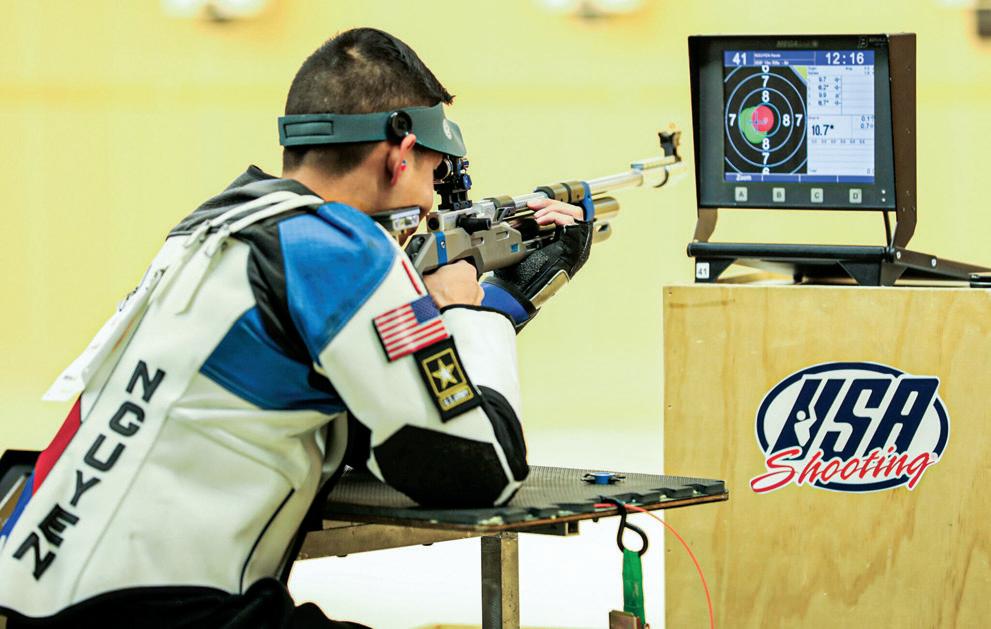
either on crutches or in a wheelchair. I can’t imagine having to face that decision. I know you’ve said you struggled with that choice. What was going through your mind as you pondered what to do?
SSKN So much went into that decision: What will my quality of life be? Can I continue to serve? Will I be able to manage on my own? Having to face that decision on my own at 20 years old was terrifying.
CC What kind of struggles with depression did you endure during your rehab time? You’d lost weight and just seemed to be in a dark place. What was that like?
SSKN Nothing about this time in my life was easy. I was isolated and felt hopeless, understandably. Pulling myself out of that mindset was one of the most difficult things I’ve ever had to do.
CC Was there ever a time when you felt guilty that you weren’t back with your unit after the injury?
SSKN Absolutely. Just like any soldier, I felt guilty for being back home in the States while my brothers were still at war. I would have given anything to have been able to return to the fight with them to do my part and try to ensure that they got home to their families.
CC And did you have an epiphany at any point that steered you back on course?
SSKN At one point, I knew I had to accept my reality and stop feeling sorry for myself. I told myself that it was time to get up and get back to work. So that’s what I did.
CC In the process of getting the amputation done and to rehab and get to where you are today as an
Army Marksmanship team member and a Paralympian, was the mental rehabilitation just as important as what you had to do from a physical standpoint? How did you find balance between the two on your journey?
SSKN I felt like I was getting back to normal. When I mean normal, I mean I wasn’t fighting any negative self-thoughts; I wasn’t wallowing in my own self-pity. I had goals; I had milestones that I was working towards. And it was a huge morale booster that I had my platoon sergeant (Sergeant First Class Robert Peredo) training with me every single day. He was my battle buddy through it all; he encouraged me, he pushed me to get better, he pushed my physical limits, and he never allowed me to slack off. We were hitting the gym twice a day, we ran, we rucked, we even shared a nutrition regiment together. I owe the majority of my recovery to him.


He and I are still close to this very day. In 2022-23, my (then) fiancé and I traveled to his home in Guam for Christmas and New Year’s vacation. He retired as an E8 (master sergeant) after 24 years of service. Where did I find the balance? Mostly through trial and error. I played around with a lot of workout regiments and plans. I painfully learned that my infantryman fit was not conducive to being shooter fit. I didn’t need to be benching 225 pounds; I didn’t need to be curling 30 pounds; I didn’t need to be (working) triceps at 90 pounds. I learned through lots of failures that I need to focus on medium weight and high reps. As much as I enjoy getting big and lifting heavy, getting big for my sport didn’t always produce the scores. After eight years of trial and error, I got the balance just right, but it also goes without saying I still continually train to maintain and meet the Army physical fitness standard.
CC Tell me how the U.S. Army Marksmanship Team became a reality for you.
SSKN It was an opportunity that was afforded to me out of the blue. It was an unexpected journey that I made the best of.
CC How much has being on that team impacted your success in shooting?
SSKN Every bit of my success can be attributed to the Army Marksmanship Unit. I’ve been blessed to train alongside some of the best shooters in the world – eight Olympians in total. I wouldn’t be here without their guidance and support. Seeing their work ethic and success was inspiring and made me work harder.
CC You seemed to be a late bloomer to shooting sports. Growing up in Westminster, did you have any interest in shooting or hunting?
SSKN No, none at all. This wasn’t a reality for me until I came to the Army Marksmanship Unit.
CC Speaking of your days in Southern California, while I think you’re a big inspiration for what you endured, it sounds like your parents inspired you when they left Vietnam after the war. Can you share some of their backstory and how their journey convinced you to join the Army and everything that’s come along with that?
SSKN My father, his brothers and sisters and both of my grandparents fled from Vietnam after the war ended in 1975. And from what I’ve been told, they were on the last few
Chinook helicopters out of the U.S. Embassy. They came to the United States in hopes of a better life. For me, joining was my way of repaying them for that freedom and to maintain the freedom that they fought so hard for.
My father and I did not see eye to eye when I first told him I was joining the Army. We fought for weeks about the issue, but I joined anyway. He really had a change of heart after I came home from One Station Unit Training. He saw how the Army had changed me and how much better it had made me. So, 13 years later, and to this day he is proud of me for still wearing the uniform.
CC I know you have a passion for skydiving and rock climbing, but have you embraced hunting at all since you’ve become a world-class shooter?
SSKN My first-ever hunting trip was to northwestern Pennsylvania. My now wife took me to her childhood farm to hunt with her family. As a California native and a Georgia resident (at Fort Moore), I’m not a fan of the cold, so she spent months trying to mentally prepare me for the misery of Pennsylvania rifle season in December. She regaled me with stories of standing in the bitter cold for hours on end.
That day, we showed up to the stand about 30 minutes before sunrise, and even before shooting time started we saw what we thought may be a deer only about 30 yards from the stand. About 30 seconds after shooting time officially started, my now sisterin-law fired a shot off in the distance, and when she did, sure enough, a huge doe popped up right in front of our stand. I took the shot as she stood motionless and broadside. By 8:15 a.m, we had her gutted and hanging and we were on our way to breakfast at the local restaurant.
To this day, my wife is still bitter about the experience and says that I had the easiest day of Pennsylvania hunting ever recorded, and that if you don’t almost lose your fingers


from frostbite, it doesn’t count!
CC The Olympic Games are significantly publicized and covered, but having competed in Tokyo and now heading to Paris, can you speak to just how dedicated, competitive and badass Paralympians are? I guess I’m just hoping we in the media can tell more of your stories and emphasize how important it is to the Games to get more exposure that you’re working just as hard in your events as happens in the Olympics.
SSKN There is a great documentary on Netflix called Rising Phoenix, and I highly recommend it. It captures and talks about the journeys of Paralympians. Paralympic athletes are just as badass as Olympic athletes. They too put in the time, the dedication, the hours, the practice and the sacrifice to be a Paralympic athlete. They also share the same struggles and victories just like everyone else. They work and train hard for four years to make it count on the one day that matters most. Every one of those athletes that show up on the field of play are out to chase the same thing: They all want to be a Paralympic gold medalist. CS
Editor’s note: The Paralympics shooting schedule website is located at olympics.com/en/paris-2024/paralympic-games/schedule/ shooting-para-sport. For more on the U.S. Army Marksmanship Unit, check out army.mil/usamu.


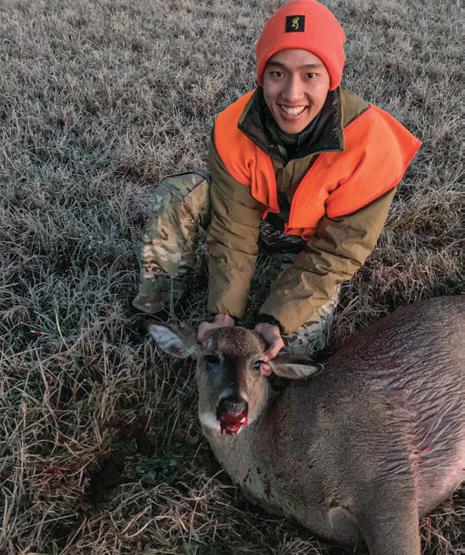


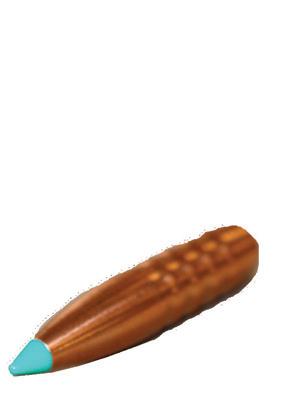



UP YOUR
FIND WHERE THEY SLEEP AND THEN HUNT THEM WHERE OTHERS WON’T.
By Tim E. Hovey
The first big game animal I ever shot was a wild pig. Out of school and employed at my first post-college job, I befriended a coworker, Eric, who was also interested in the outdoors.
Eric and I would peel off after work and fish the Southern California lagoons for spotted bay bass and halibut. On weekends during hunting season we’d head out to public land and look for small game or upland birds.
During our first hunting offseason as friends, we started looking into hunting wild pigs. Eric found a Central California pig guide who was reasonably priced. We booked a weekend hunt and headed to the Monterey County town of Parkfield.
That first morning, we were led to a hill overlooking a barley field in the dark. Our guide explained that the pigs fed in the evening and headed back to their beds at first light.
As soon it was light enough to see, the barley fields began to vibrate with activity. The vegetation would move in a line, indicating that pigs were on the move. Single file, they appeared in all sizes at the end of the field and started trotting towards the fence line. Once they were on our side of the fence, the guide whistled and every single

pig froze. Two shots rang out and two larger pigs dropped where they stood. The remainder of the group scattered.
I remember everything about that pig hunt that occurred close to 30 years ago now. On the drive home, Eric and I discussed how we were both interested in doing that again, except on our own. That ended up being the first and last guided hunt either of us would go on.
Eric and I hunted and fished together a few more years before the responsibilities of life took us in different directions. However, that pig hunt changed me forever. I became even more obsessed with hunting them and learning all I could about their habits.
LIKE MOST WILD ANIMALS, the pig population in California is heavily tied to the seasonal rains. In good water years, pigs thrive, with sows having two litters, if not more, throughout the wet year. Conversely, during droughts, sows have fewer piglets





and may only breed once or not at all when resources are sparse.
When the weather is cool, pigs will move throughout the day. As soon as the weather warms or if pigs become pressured, they’ll start to become nocturnal, moving more during the cooler evenings. During warmer days, they’ll get down in their beds, often using the same locations to wait out the heat of the day. These bedding areas are often close to either a food or water source.
When I first started pig hunting on my own, I simply copied the techniques of the guided hunt. I looked for food sources and set up nearby. I had some moderate success, but this involved being at the hunting spot before first light. I found that if I was even a little bit late, I would miss my opportunity.
In 2010, I was making the drive home after an unsuccessful pig hunt when I started thinking about what I


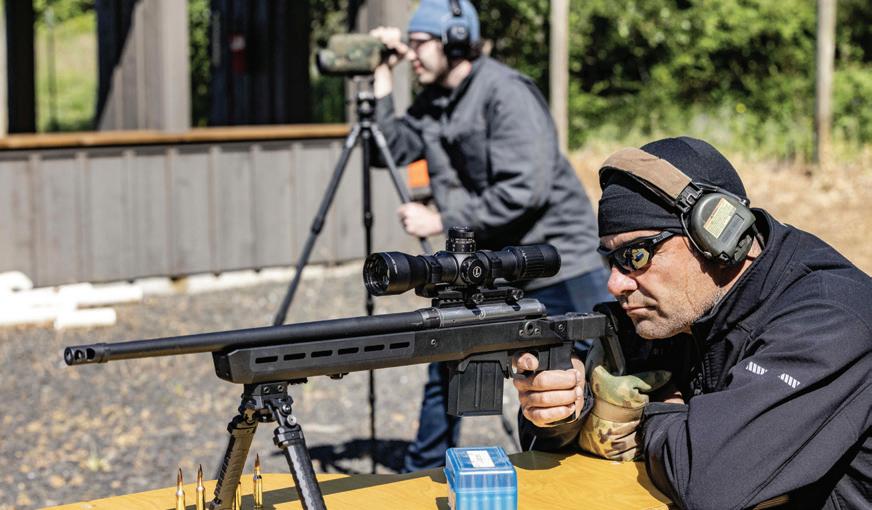


had learned to that point in time and how I could become more successful. No matter how I thought about it, it all came down to widening that shot opportunity window. And that came down to finding where the animals spent much of the day; I needed to find where they bedded down.
I began reading everything I could, visiting pig hunting forums and looking over their biology. I didn’t see a lot of information on sneaking into their beds during the day; most hunters hunt the pigs early when they’re on the move. Enlighted about their habitat requirements and by what I’d observed during my previous hunts, I
The author’s lever-action .30-30 was the right tool for downing this tusker. It’s a DIY tradition he’s enjoyed for years now since his first guided hog hunt. (TIM E. HOVEY)
and head out to explore with a rifle strapped to my back.
At the location, I would glass the area from a distance. I’d pay special attention to the wind direction and stay downwind of the bed. Pigs have a musty smell and often I’d get a strong whiff downwind of the bed. I looked for moving vegetation within the bed, dust clouds indicating pigs dusting themselves, and, of course, pigs themselves.
Finding pigs may seem like the hard part, but once I found a bed occupied, I needed to go in and get them. Making the decision to do this exposed me to some of the most exciting types of hunting I’ve ever done.
Pigs that are disturbed from their beds often get confused; while they flee, they usually stop a short distance out and turn back to see what had kicked them up. That’s usually your shot opportunity.
I traded out my long-range rifle for a short-barrel lever gun chambered in .30-30. I also strapped a .357 revolver to my hip and never went into a pig bed without it. If you play the wind right and stay quiet, you can literally walk up on sleeping pigs.
These areas are often unpressured and tough to reach, but the rewards will be worth the hike in. Many of the pigs will be exhausted from the night’s activity and will be sleeping or heavily rested. Sneaking in requires a very quiet stalk.
began to learn on my own.
PIGS WILL BED DOWN where they feel safe. This also happens to be some of the nastiest vegetation out there. It’s often in the crease of shallow canyons where the thickest poison oak thrives. They create tunnels and beds in this thick stuff and share these bedding areas with a dozen or more individuals. They’ve learned that staying in groups will help in detecting danger.
I began poring over Google Earth to find areas that were remote, located near either water or food, and definitely off the beaten path. I’d load the areas I wanted to investigate into my GPS
I’ve kicked up hundreds of pigs by hunting them where they bed. My hunting success rate went way up once I found where they spend most of the day. Sneaking into their bedrooms while they sleep is exciting and an adrenaline-filled hunt. The closest I’ve ever gotten to a bedded pig is 18 inches. And he never knew I was there.
ALL HUNTERS WOULD LIKE to be successful. This often means going the extra mile and getting off the beaten path.
If you want to increase your odds and move beyond long-range shooting, find where wild pigs sleep and hunt where others won’t. CS




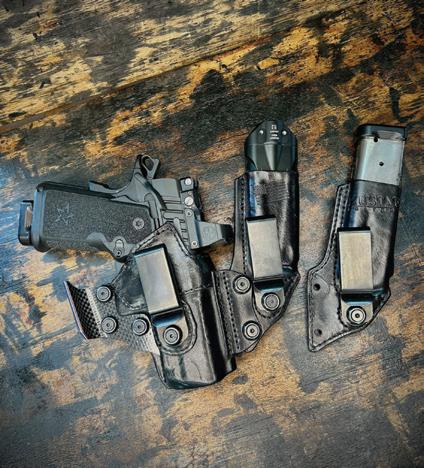

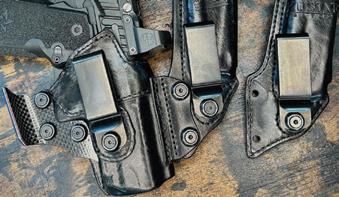



By Scott Haugen
Whether you’re looking to jumpstart your upland bird season with a preserve hunt or are getting ready to pound the ground on the general season openers, here’s some gear to consider.
Last August, I was hunting ptarmigan in Alaska when I accepted the fact that the hunting vest I’d used for so long was finally in need of replacement. Contemplating what vest to get, I chose the Orvis Pro LT Hunting Vest ($198, orvis.com). This is the first piece of Orvis hunting attire I’ve owned. I was impressed with the fit and efficient functionality and it accompanied me on many hunts in multiple states throughout the rest of the season.
I like ergonomic, easy-to-adjust vests that fit properly and aren’t too loose in key areas. This vest qualifies. It’s light – nearly half the weight of their popular Pro Series Vest – and comfortable to hunt in all day long. The number of pockets and pouches make for easy loading and unloading and they keep gear clean and organized. The padded suspension, adjustable hip pockets and streamlined straps make for an easy, comfy fit.
I also got the Orvis Pro Upland Brush Pants. From chasing valley

Now

By Tiffany Haugen
Whether you’re going fishing in hopes of bringing back fresh halibut or looking to cook what’s in the freezer, this is a recipe you’re sure to love.
Due to its lean nature, halibut can be a tricky fish to cook. Just an extra minute on the heat will dry it out, thereby compromising flavor and texture. Baking in a flavorful, creamy sauce takes the guesswork out of the equation while producing a

comfort food you will want to make again and again. This recipe also works well with other bottomfish too.
1½ pounds halibut
3 tablespoons butter
8 ounces mushrooms, sliced
½ teaspoon granulated garlic
¼ teaspoon salt
3 tablespoons flour
1 cup peas
1 cup chicken stock
½ cup half and half
1 tablespoon sherry
½ teaspoon pepper
TOPPING
¼ cup butter
2/3 cup breadcrumbs
½ cup french fried onions
Prepare topping by melting butter in a small skillet and mixing with breadcrumbs and french fried onions. Set aside to cool. Cut fish into bite-sized chunks and place
in a single layer in a heavily buttered oven-safe casserole dish.
In a large, dry skillet, sweat mushrooms on medium heat for four to five minutes. In a small bowl, combine chicken stock, half and half and sherry. Add butter, garlic, pepper and salt to the skillet and sauté two minutes. Sprinkle flour over mushrooms and sauté another minute.
Increase heat to high and slowly add liquid mixture, stirring constantly. Once sauce begins to bubble and thicken, remove from heat and add peas. Add more salt to taste if desired.
Pour sauce over halibut and top with breadcrumb layer. Bake 20 minutes in a preheated 350-degree oven.
Editor’s note: For signed copies of Tiffany’s popular book, Cooking Seafood, and other best-selling titles, visitscotthaugen.com.



Looking for a low-recoil 12-gauge load that kills with conviction while being easy on very old guns or extravagant ones? Baschieri & Pellagri’s 2.5-inch Upland Game Classic shells could be it. (SCOTT HAUGEN)
quail in creek bottoms, to Huns in rolling hills, to ringnecks in fields and chukars in rocky mountains, these pants were comfortable and took a beating. I loved their ability to shed extremely heavy overnight dew, then breathe as the morning warmed up and my body temperature continued to climb.
They held up in thistles, briars and when wading through thorny groves of rose hips. Tough but not constricting, their state-of-the-art technology and design resulted in a freedom of movement in the knees, thighs and waist. The shin, knee and thigh areas are also reinforced with rugged paneling, none of which are binding.
THESE BOOTS ARE MADE FOR HUNTING
When it comes to boots, I’m very picky. You can be wet, cold, hot and
uncomfortable all over, but if your feet fail you, the hunt can come to a sudden halt. I’ve worn some incredible boots over the years, and the new LaCrosse Ursa ES GTX immediately caught my attention ($250, lacrossefootwear .com). When I looked at them in the box I thought they were the wrong size because they were so streamlined. And when I pulled them from the box, their light weight was impressive. I put them on, wore them around the house and instantly liked them.
I’ve logged dozens of miles in them without a hotspot, turned ankle or sore feet. They’re like a high-top tennis shoe on steroids. I’m not a fan of bulky, stiff boots when it comes to covering ground on upland bird hunts. But these boots are waterproof, breathable, agile and comfortable. I’ve hunted in them throughout the
West and South Africa, and they’ll be going to Alaska with me this month.
Tearing my rotator cuff last summer greatly impeded my ability to swing and shoot for several weeks. I needed a lightweight gun I could wield. I found it in Benelli’s 828U in a 20-gauge with a 26-inch barrel ($3,100, benelliusa.com). This lowprofile gun is light and instantly felt like an extension of my body due to the streamlined fit and feel. It shot lights-out. I even killed a number of birds when having to shoot onehanded due to my shoulder pain.
I test and shoot a lot of shotgun shells, and a unique one that instantly caught my attention was the Baschieri & Pellagri Upland Game Classic (baschieri-pellagriusa.com). I

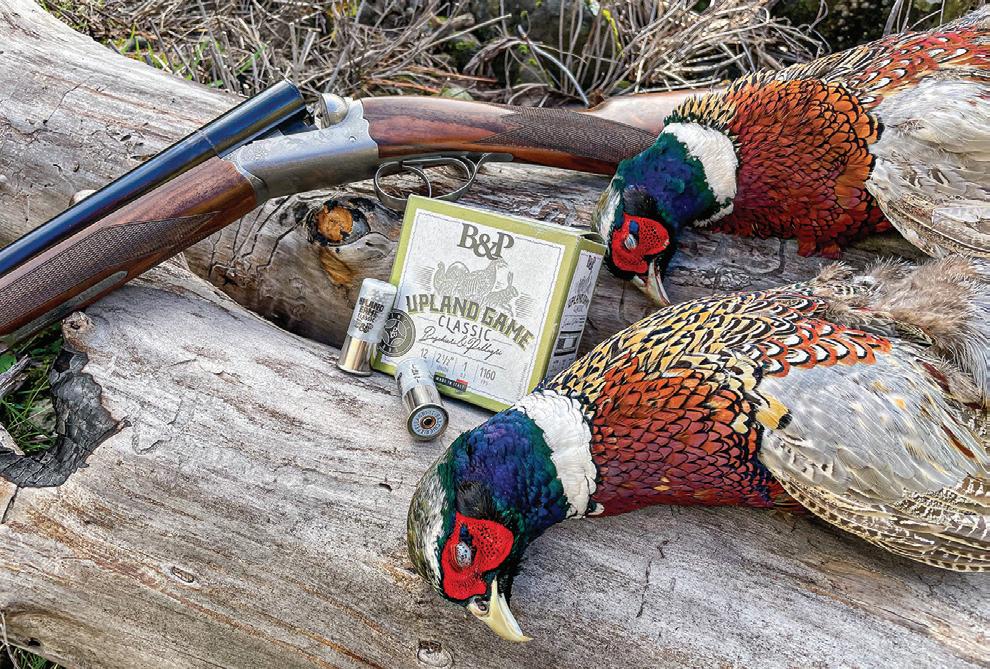
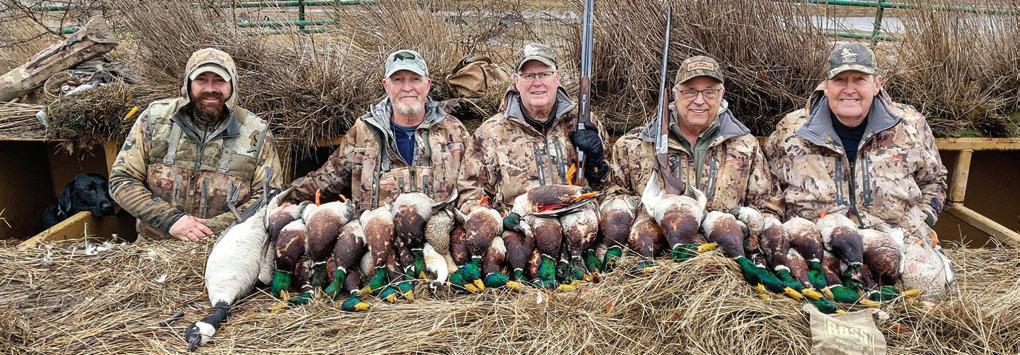









first fired these rounds in a doublebarrel gun that was four times the value of my first car. I also shot it in a couple old 12-gauges that have been in the family for generations, ones I didn’t want to risk shooting magnum loads in. With my shoulder issues, I also shot this shell in newer guns while on the hunt. Available in 12-gauge, these short-chambered 2½-inch shells offer low recoil and minimal pressure. It’s gentle on old guns and easier on the shoulder than beefier loads. It killed doves, pheasants and Huns with authority.
If looking for a fun, quiet way to cover ground and hunt alone or with your dog, check out a QuietKat electric bike. I picked up the Apex Pro ($5,000, quietkat.com), which
is a solid bike. The amount of ground you can cover is impressive. My dogs love hunting in front of it, as it allows them to work faster, and it’s so quiet that communicating with my dogs is easy. If hunting areas that are open to the use of nonmotorized vehicles, this could be what you’re looking for.
My ability to cover ground hunting quail on the edge of farm fields as well as grouse in the rolling hills has greatly increased, thanks to this bike. I’ve used it to access bandtail pigeon areas, shed hunt, and even hunt fall turkeys with my dogs. The pedal assist is efficient when climbing hills and battery life is plentiful.
A knife that’s great for breasting out upland birds and breaking down legs
and thighs is Benchmade’s Flyway ($200, benchmade.com). The first time I butchered a limit of birds with it, I thought it was the last upland bird knife I might ever need. A year later, I still believe that. I’ve run that blade through over 500 birds – upland and waterfowl – and have yet to sharpen it.
When it comes to gear, I’m of the mindset that quality goes a long way. I’d rather spend more for something I know I’ll have for years, or that it will fit comfortably and perform to my expectations every single time I use it. All the gear we’ve just looked at does exactly that. CS
Editor’s note: For signed copies of Scott Haugen’s best-selling books, visit scotthaugen.com. Follow Scott on Instagram and Facebook.

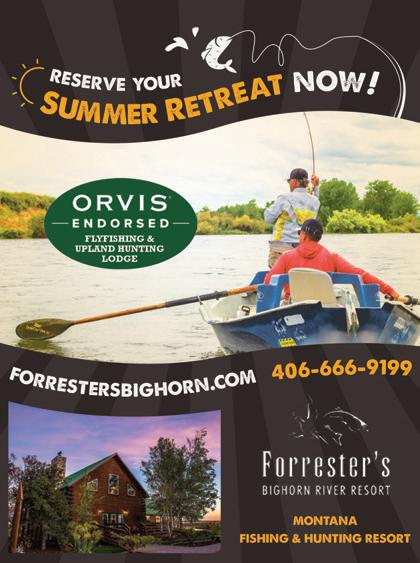


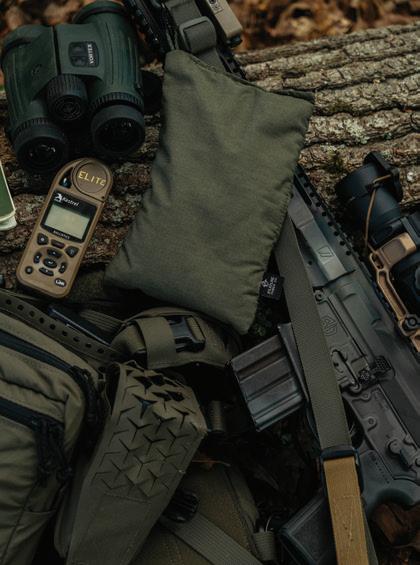




By Scott Haugen
Spring and early summer may seem like the most dangerous time for grass seeds and dogs, but the next few months are every bit as critical. Now is when grass seeds have baked in the summer heat and turned hard as a rock, and worse yet, they’re laying on the ground.
Earlier in the summer, concerns focus around gun dogs inhaling seeds as they run through tall grass, or getting them lodged under an eyelid or in an ear. Valid concerns, no doubt, but now is the time when many gun dogs suffer from barbed seeds that get
burrowed into their feet, and it can bring their hunting season to a halt – or worse.
Foxtail seeds, often called awns, are the most dangerous in our region. This noxious grass produces a cluster of seeds at the top that resembles a fluffy fox tail. When the seeds drop off the stalk, their backward-facing barbs are designed so the seed can “dig” into the ground in coming months. If a dog steps on them, these barbed seeds can become embedded in the toes or webbing between the digits and keep working their way into the dog’s muscles, even body cavities.
LAST FALL, A BUDDY’S dog got a foxtail in its foot. It traveled up the front leg. He took the dog in for surgery and though they split the leg all the way up, the seed couldn’t be found. After a $5,000 vet bill and no seed, they put the dog on antibiotics. Today it’s doing fine. That was one of the lucky dogs. These nasty seeds have been known to travel all the way to the spine and cause nerve damage, even death by infection when abscessing in parts of the body. My vet told me last summer that on average he saw one dog a day with a foxtail in the foot; in years prior, the average was one a week.

After probing into Kona’s foot with long forceps for a barbed seed without success, author Scott Haugen and his vet decided to leave the wound open to drain. Antibiotics prevented infection and luckily, the seed eventually festered and popped out atop the knuckle.
Both of my pudelpointers got foxtails in their feet last year. Neither dog showed any sign of discomfort. They kept running, worked hard on every hunt and training session, and never licked, limped or whined. In both dogs I noticed inflamed pink spots between their toes when drying their feet after a hunt.
Kona’s spot was red and inflamed. After a couple days it festered and I tried popping out the seed. It didn’t happen, so the next day I took Kona to the vet. They sedated him and fished around the entry wound with long forceps, hoping to latch onto the seed. They couldn’t find it. I had a decision to make: leave it and hope it festered and popped out, or have surgery? Surgery would mean a long recovery time and a lost hunting season. Because the festered area
seemed localized around a knuckle and not migrating up the leg, my vet and I concluded I’d just keep an eye on it. Five days later, the seed worked its way out – half an inch from where the vet tried digging it out.
TWO MONTHS LATER, ECHO picked up a foxtail in the webbing of her toes. It entered more from the bottom. A visit with my vet left us hoping the seed would continue traveling in a straight path and pop out the top of the foot.
“If it doesn’t pop out in a few days, bring her in,” he told me.
It didn’t.
“The seed doesn’t seem to be moving, and rather than dig around, let’s just see what happens,” the vet next advised.
The redness and swelling hadn’t progressed, and the wound was
sealed. Echo was going full speed, even duck hunting a few times a week. My thinking was the more active she was, the greater the likelihood of the seed working its way out. The vet put her on antibiotics. Twenty-three days after I noticed it, the seed festered and I pulled it out. The barbs were sharp and the seed hard.
I was under the assumption these seeds eventually dissolved. My vet told me otherwise. Echo only missed a few days of hunting. Because Kona’s wound was open, he missed two weeks of hunting.
I’VE ALWAYS TRIMMED THE hair on the feet and between the toes of my dogs in order to prevent grass seeds from getting caught. Then a trainer told me he leaves the hair between the pads long so that it captures the seed rather than having it directly puncture the skin and immediately start burrowing in. He did emphasize that if I kept the hair long, to check it regularly – multiple times a day, in fact – because spiked seeds are more easily trapped in the hair and need to be removed fast.
There are other spiked weed seeds to watch for as fall progresses. Some of these seeds drop early and some stay on the vine until heavy rains knock them off. These seeds aren’t as lifethreatening as foxtails, but they can cause serious eye and ear damage, even infection, if they go unnoticed.
The best grass seed prevention is continual inspection. Look for seeds, feel for them in longer hair and brush any areas of concern. Don’t count on a working gun dog to let you know there’s an issue, as their drive overrides any pain or irritation they might be experiencing. By being aware and prepared to deal with dangerous seeds, not only can you save your dog’s hunting season, but possibly its life. CS
Editor’s note: Watch Scott Haugen’s basic puppy training videos and learn more about his many books at scotthaugen.com. Follow his adventures on Instagram and Facebook.

